Tucked alongside a 6 kilometer sea trunnion sits a unique and picturesque town that literally translates to ‘Old Town’.
On Hvar Island, sitting to the north of Hvar Town, you’ll find Stari Grad, a quaint little place away from the hustle and bustle of everyday life. As one of the oldest towns in Europe, founded somewhere around 3,000 BC, the town has undergone many historical milestones and maintained its protected position at the very end of a large bay. Enjoy the peaceful surroundings of this beautiful town, treat yourself to its boundless konoba’s, delve into its affluent history and spend your days basking in the Stari Grad summer sun through the town and surrounding beaches.
History of Stari Grad
With a name like Stari Grad, you can expect a long and historic history to follow suit! Stari Grad's history dates back further than many realise; when the Venetian’s founded what we know as today’s Hvar in the 13th century, Stari Grad had already existed and been through a prolific amount of history itself - 17 centuries prior to be specific!
Most of Stari Grad’s history revolves around a strong Greek dominion. During the 4th century Hvar was colonised by Ioanian Greek settlers from Paros and whilst they noticed an already established Illyrian community, they cemented their rule along the coast and pushed the Illyrians toward the mountains. Their settlement proved to be very progressive with the towns Plain, Chora Pharou, being the best preserved example of a cultural landscape from the Greeks. It has remained virtually unscathed since first being colonised, so much that it became Croatia’s 7th location protected by UNESCO.
From the Renaissance period to modern day, Stari Grad experienced pivotal historical shifts. This period saw the invasion of the Ottoman Empire where there was much destruction to the town. Although despite much demise, the spirit of Stari Grad lived on and they built up the towns now iconic stone buildings and dreamy cobble streets during the 17th and 18th century.
Come the 19th century and the Stari Grad that we know and love began to come together. In 1813, Hvar became part of the Dalmatian Kingdom which gave the island much prestige, seeing an abundance of potential and opportunity which extended to Stari Grad. Once a hotel had been built in the 20th century Stari Grad, the destination became a prominent holiday choice and well loved tourist destination.
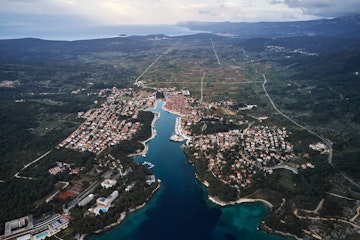
The Best Way to Get to Stari Grad
Many opt to get to Stari grad via Hvar, as a direct connection to Stari Grad is only undertaken by car ferries who dock at the Stari Grad port. If you don’t have a vehicle, which many travellers don’t, the most efficient way to get to Stari Grad is to catch a ferry or catamaran to Hvar and then take a 30 minute bus to Stari Grad.
The journey to Hvar is best taken from the coastal city of Split, as this is the quickest route. The journey is roughly an hour long and will deliver you to Hvar’s port in the Old Town. Prices vary depending on the season and can cost you anywhere from €6 - €20.
The most direct route from Split to Stari Grad is undertaken by a singular company, Jadrolinija. It will take 2 hours to reach the Stari Grad port and tickets vary from €5 - €7, with 7 departures daily during the summer months. If walking is comfortably feasible for you, a 4 kilometer stroll along the riva will get you to the town, alternatively, you can hail a bus that will drop you off near the bus station situated in the town center. For bus departures in Stari Grad you can visit the bus timetable here.
In the summertime a connection from Dubrovnik is available, however given its distance, the journey will take 3 and half hours to Hvar.
For the full list of ferry timetables you can visit this website here or here.
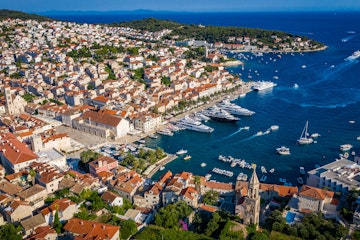
Things to do in Stari Grad
- Hike Up To Glavica Hill
Glavica Hill is an 111ft elevation that overlooks the ancient Stari Grad below. Glavica literally translates to ‘little head’ which could potentially pay tribute to the little heads dotted along the hill if you were looking from below!
Hiking up to Glavica Hill is feasible for all levels of fitness. It’s a relatively easy incline that only becomes slightly narrow towards the top. True to Croatian terrain, the hike is accompanied with dense pine trees along the edges which will provide much loved shade for those tropical summer days. The 20 minute trek will then open up with panoramic views of Stari Grad below and you may even catch a glimpse of neighbouring towns. Given the capability of these views, it was thought that this hill was once a lookout post!
Glavica Hill contains a few attractions, most notable the striking white cross that’s perched towards the edge. The cross can be seen for miles around the towns and truly acts as a beacon for Glavica. The original cross was destroyed during WWII and as a symbol of the times, it was rebuilt in 1990. The new cross was fabricated using remnants from the old cross’ altar and has since remained undamaged. A small Catholic chapel can also be found on the hill where locals leave offerings and pray to the patron saint.
Whilst the cross and small chapel nearby are newer additions to the hill, they rest on the ancient stone which is traced back to the arrival of the Greeks.
Our top tip: Visit the hill at sunset for incredible and colourful views of the sun setting across a panoramic horizon.

- Stroll through the Stari Grad Plain
Sitting in the center of Hvar island, an ancient site over 2,400 years old remains the single most untouched example of Greek cadastral in the entirety of the Meditteranean. Say hello to the Stari Grad Plain!
At first glance, the Stari Grad Plain doesn’t seem to invoke the same appeal as it’s other UNESCO established locations such as Plitvice Lakes or Krka National Park, but what this site lacks in typical Instagram aesthetics, it makes up for in passionate heritage.
The plain, which stretches 6 kilometers from Stari Grad to Vrboska, was initially colonised by the Ionian Greeks in the 4th century. The impeccable nature of this natural reserve has since become the cornerstone of agriculture throughout Europe, given its longstanding success. For over 24 centuries, the plain has been maintained in its original form by locals - right down to the produce it grows; olives and grapes!
Meander your way through this quintessentially ancient site discovering the limestone walls that are fashioned in a geometric design. The plain is subdivided into 75 parallels that span over 1,300 hectares, also known as ‘chora’. Dotted along the paths you can discover quaint country huts; unique beehive-shaped structures that acted as storage way back when, and even cisterns that formed part of rainwater systems.
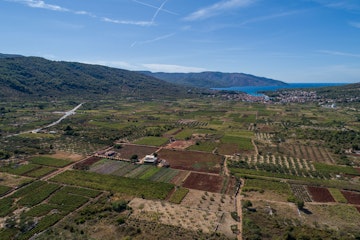
- Taste Ancient Wine at Hora
Tantalise your tastebuds with Dalmatian delicacies at Hora Farm! Found within the heart of the Stari Grad Plain, the Hora ranch promises a unique hospitality experience where you can sample some of Hvar’s finest wines, cheese and oil from the UNESCO protected Ager Wine Field. Synonymous with visiting Stari Grad is the opportunity of a wine tasting on this fertile field - an experience you can’t pass up!
It’s believed that Hvar was the first area in Croatia to start making wine, taking the actual fruits of their labour from the Stari Grad Plain - it’s no wonder that the acclaimed wines are the talk of the town!
Hora Farm is a family-run business who shares an unparalleled passion for their produce. A crowd favourite, and indigenous to Hvar, is Bogdanuša, which translates to ‘godsend’. This white grape variety features floral accents and is a godsend for many who taste the delicious elixir for the first time! There are 4 specialty wines produced by the ranch that can be paired with delicious grazers chosen by the farm.
Hora operates daily from May to October and a wine tasting experience costs around €30. You can reach the farm via bus from Stari Grad which will take you 15 minutes, or you can stop by during a stroll or cycle of the plain.
If you’ve booked a cruise with Sail Croatia, Stari Grad is most likely a stop on your itinerary and you’ll be able to take part in a wine tasting excursion if it is of interest!
- Visit the Stari Grad Museum
With a history as long as Stari Grad’s, a museum to display its extensive past is a given. Discover all the wonders and artefacts of Stari Grad’s history inside a treasure itself - the museum resides in the 19th century Neo-Renaissance palace once home to the Biankini Brothers dating back to 1896!
Uncover archeological collections dating back as far as 6,000 years. The most popular attraction is the Roman merchant ship’s cargo that shipwrecked in the 4th century AD, full of amphora on its journey from North Africa. Take a detour to the garden where there’s a century old Deodar Cedar tree dating back to the same period as the palace grounds before making your way towards the Gelineo Barvaldi which showcases treasures from prestige figures from the 18th and 19th century.
The museum also provides viewings of modern art from local painters celebrating both the past and present of Stari Grad.
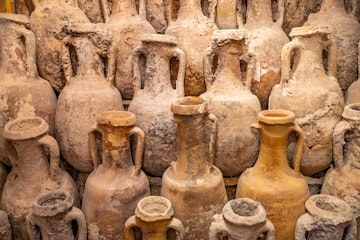
- Stroll the Venetian alleyways
One of, if not the, best ways to experience a destination is to essentially get lost in it, and nothing rings more true than in Stari Grad. Where major cities are packed like sardines around every corner, Stari Grad is blissfully vacant, giving you the chance to take in every possible discovery undisturbed. Stari Grad’s Venetian alleyways are much smaller than larger cities like Split and Dubrovnik and walking the entirety of tangled streets, where time has stood still, is more than achievable in a day. Around every new turn there is something to discover; from quaint cafes to ancient archways, and delightful eateries, all of which tend to pique your interest!
As you lazily stroll in your tranquil state, you’ll inadvertently find your way in the midst of Srinjo Kolo; the once epicenter of Stari Grad! Stippled with a hipster-esque array of deli’s, cafes and of course souvenir houses, a forever memory, whether through a flavour from the deli or a keepsake from the boutiques, are highlights of your time meandering through the cobblestoned Venetian streets.

- Eat lavender ice-cream
On an island with a surplus – and even a festival – of the natural bloom, lavender ice-cream is the offbeat local treat you need to try. An old saying goes, ‘rose is the scent of the heart, lavender is the scent of the soul’ - what’s better for the soul than treating yourself to ice-cream!
The combination of a creamy base paired with the floral flavour of lavender creates a pleasant surprise for your tastebuds. The aroma of lavender will follow you around the island so procuring it in all forms, including a dairy delicacy, is a must! With so many stalls and gelaterias around Stari Grad, you’ll just have to try them all to find your favourite - life is tough!

- Enjoy the Stari Grad Riva
Embrace the unhurried and leisurely charm of the Stari Grad Riva. Just as all roads lead to Rome, all of Stari Grad’s streets lead back to the Riva, enticing you back almost as if a siren calls your name. The palmed waterfront promenade has a romantic allure, whether you find yourself wandering past centuries-old Venetian buildings, or unwinding at an al fresco eatery, coffee in hand, watching the locals pass the time. Embrace the unhurried and leisurely way of life on the Riva in this ancient town, taking your time to seize as much of the beautiful sights as possible.
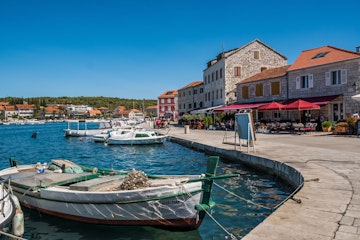
Top Bars in Stari Grad
Just as Stari Grad has remained a constant throughout the centuries, so too has their way of life: quiet and quaint with no real hint of urgency. Whilst there is no party atmosphere in this quaint town, that’s not to say that there isn’t a place in town to enjoy a cocktail or two!
Lampedusa Bar
Right on the Riva enveloped in a chill atmosphere, Lampedusa Bar sits overlooking the marina. This is the place to quench your thirst with delicious drinks. The appeal of this cocktail bar is the array of drinks on offer. Devour signature cocktails and premium G&T’s in this seaside spot which is especially beautiful during golden hour. We recommend asking the bartender for a speciality drink that they can whip up for you!
Hvar
For the hottest nightlife, epic clubs and even better drinks, Hvar’s the neighbour you’ll be glad to have. From beach bar drinks to a train of flaming shots, Hvar has you covered. You can find all the Top Party Locations in Hvar here for a nightlife experience like no other!
Where to eat in Stari Grad
Konoba Batana
A hidden gem only open for dinner, Konoba Batana can be found in the heart of Stari Grad through a seemingly unostentatious arched wooden door that could be something right out of a fairytale. Batana has minimal seating inside, and a handful of tables along the alleyway, where you can enjoy authentic and, most importantly, Stari Grad small town cuisine.
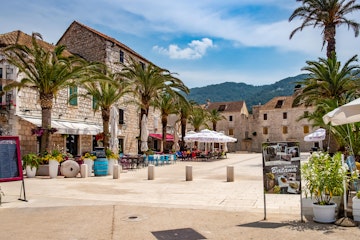
Antika
Antika is worth the journey to Croatia in its own right! It’s one of Stari Grad’s most traditional restaurants with a keen eye on seafood dishes and a great bang for your buck. There’s much to love about Antika, but a special mention goes out to their dining spaces. Overall, Antika has a quirky and unique essence to its space, but it’s the choice between the ancient townhouse built in 1566, the tables dotted along the cobblestone alleyway or the ‘secret’ upstairs terrace that really make this location an unmissable eating destination.
Our Top Tip: There’s many local wines and cocktails you can sample but don’t pass up trying the White Russian – it’s their speciality!
Jurin Podrum
It’s a favourite for locals and travellers and it’s not hard to see why! Tucked away in a secluded alleyway, Jurin Podrum is a family-run local bistro that has been operating since 1917 – you know their menu is worth the hype if they’ve been around this long! Many travellers boast about this restaurant for their menu’s uniquenesses, one which you can’t put your finger on but there is a discernible difference in each dish. The restaurant also grows produce in their own garden as well as their own olive oil!
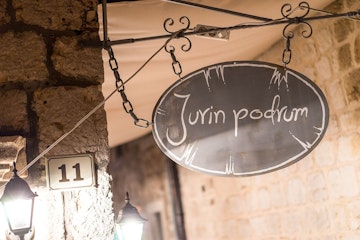
Kod Barba Luke
Residing in a stone house built in 1643, Kod Barba Luke is one of Stari Grad’s oldest restaurants. This family business can be found in the main square of Stari Grad which makes for a convenient stop when exploring the town. Delicious Meditteranean and European cuisine are on the menu but this progressive restaurant also caters to gluten-free travellers and vegan dishes are available on request! Enjoy your food inside or out of the premises, although the terrace provides beautiful views especially under the palms.
Old Town Attractions
Tvrdalj Palace
The most famous building in Stari Grad is awarded to Tvrdalj Palace which was the summer residence of Renaissance nobleman and poet, Petar Hektorović. Hektorović began construction of his summer abode in the mid 16th century where his realised idea of microcosm came to fruition – the idea that all divine creatures, including fish, birds, plants and people, had a space to live in a self-sustaining enclosed world. Hektorović dedicated his life to building this villa which ultimately demonstrates an inherent artist essence.
The most prominent attraction is the interior courtyard housing a seawater fishpool encircled by a vaulted terrace. The water inside transforms into a plethora of different hues ranging amidst the full spectrum between blue and green depending on the time of day – most of the living spaces within the palace were designed to join off the pool as well! True to his microcosm design, the land side of the residence holds a large walled garden that, in its prime, grew herbs and medicinal plants. Hektorović eventually shifted his design focus when the Turkish raids by the Ottoman Empire began. This saw Hektorović fortify his walls and the area became a sanctuary for those seeking shelter from the attack. Due to this, travellers can now witness a juxtaposition between the two significant experiences of Hektorović’s life, art and war, within the confines of his villa.
The cost of entry into the palace, around €3, is devoted to maintaining and staffing the property to support the well-preserved nature of this historic building.
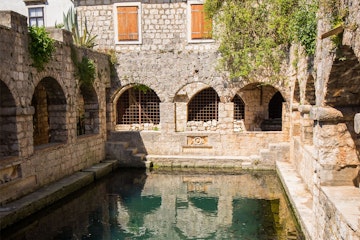
Trg Škor
In the very heart of Stari Grad, lies one of the most beautiful baroque squares of the town; Trg Škor. Established between the 17th and 18th centuries from a former shipyard, Škor took its name from ‘skver’ deriving from the Dalmatian name for shipyard. Škor was also once the home of nobles in Stari Grad before housing the working-class. The ancient stone villas and renaissance architecture are apparent within the enclosed square with iconic roof windows, known as luminari, and typical Dalmatian stone terraces with staircases appearing on the structures. Aside from the few cafes, during the summer months, Škor hosts many cultural events and festivals which we recommend to visit. Whilst humble in size Trg Škor is a monumental attraction for Stari Grad.
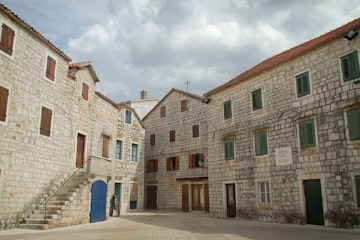
St. Stephen’s Church
St. Stephen’s Church holds much prestige in Stari Grad. Not only was it the first cathedral on Hvar island, this parish church was the most important public space in Stari Grad. During 1605, the construction of this acclaimed church began on the site of a 9th century church, by local masters converting it into a baroque style three-nave basilica which was then decorated by Venetian artists.
A bell tower was built shortly after in 1753, accompanying the parish church. To this day, St. Stephen’s and the bell tower are the most successful expressions of baroque architecture within Dalmatia.
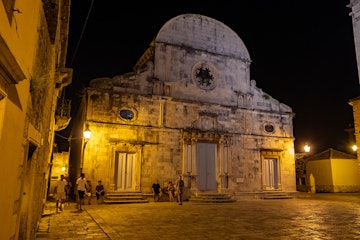
Dominican Monastery
The Dominican Monastery was founded in 1482 by a friar with the help of the locals. Not long after this, in 1571, the premises was damaged by the Ottoman invasion which compelled the decision to fortify the building with two round turrets. A courtyard brimmed with various greenery all bloom within the enclosed garden surrounded by arched walls, much like Trvdalj Palace. The Dominican Monastery was also the final resting place of Petar Hektorović, whose tomb resides inside.
Where to Stay in Stari Grad
There are many accommodation options that will have you staying right in the heart of Stari Grad, making for a peaceful escape! There are various platforms where you can book everything from luxury locations to more budget-friendly options. We recommend using a search engine such as Airbnb for all of your accommodation needs.
Explore Nearby Towns
Stari Grad is luckily connected to many nearby towns on Hvar Island, all of which have their own unique appeal. If you’re based in Stari Grad, we would recommend hiring a car or scooter and exploring the best of the island’s towns and villages!
Rudina
Only 2 kilometers north of Stari Grad lies the idyllic village Rudina. A place where time stands still, this village is populated with only 19 inhabitants! Rudina is divided into two smaller communities – Vela Rudina and Mala Rudina – which are part of 6 eco-ethno villages on Hvar that are committed to the perseverance of Croatian beauty. In this quiet town hides a small square that’s protected by the Republic of Croatia as a cultural heritage site. Here you’ll find ways of times past including an olive and grape mill.
If you find yourself on Hvar Island in August, Rudina hosts the annual Rudine Art Festival, where you can meet local artists in the Old Town streets.
Hvar Town
Just 13 kilometers from Stari Grad, the ‘French Riviera’ of Dalmatia is perched on the island's namesake. Hvar Town is a must-visit and a crowd favourite. Hvar Town is rooted in deep history, features a beautiful Old Town and is the place to be if you’re looking to rub shoulders with the elite and famous! For all the ins-and-outs of this magical town, head over to our Hvar Destination Guide.
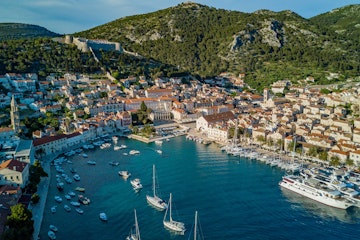
Dol
Only a hop, skip and jump away from Stari Grad lies the village Dol. Like Rudina, Dol comprises of two valleys; St. Mary’s Dol of the west and St. Ana’s Dol of the east. Dividing the two valleys, the Church of St. Michael the Archangel sits on top of a beautifully shrouded hill. Along with Stari Grad, Dol is one of the oldest villages on the island and dates back to prehistoric times. This is evident thanks to the archeological discovery of the Illyrian fort, Purkin Kuk. For a spectacular experience of Dol, it is highly encouraged to cycle or hike through the valleys to take in the particularly beautiful ancient sites of the village.
Jelsa
On the north coast of Hvar Island lies Jelsa; a small harbour town that's perched on the foot of a picturesque bay. A quick 10 minute drive from Stari Grad, Jelsa is a quiet neighbour filled with fabulous swimming spots, intimate streets and eye-catching squares. From Jelsa you can see the two highest peaks on this island, St. Nikola and Hum, and discover the most significant prehistoric site in the Adriatic, the Grapceva Cave.

Vrboska
Vrboska is the smallest town on Hvar island and is protectively tucked into the base of a deep bay. The town's position makes it one of the two safest ports in the Adriatic as it is perfectly shielded from the wind. Stone bridges arch over the running canal connecting the town to an island in the middle of the bay. Beautiful facades and a fortress church, among others, are discoverable sights in this town that is just 6 kilometers east of Stari Grad.
Visit the Best Beaches in Stari Grad
Maslinica Bay
Dip your toes in the shallow shores of Maslinica Bay, located just 2.5 kilometers southwest of Stari Grad’s center. The major appeal of this beach is that it’s grounds are lined with a sandy shoreline, making it the only sand beach in Stari Grad! Maslinica is easily accessible by car however amenities are desolate, so come prepared to spend the day at this supreme spot!
Banj Beach
On the northside of the Stari Grad bay sits a petite pebbled beach that is protected by dense greenery. Banj Beach is 1 kilometer northwest of Stari Grad, making it the closest beach to the town. Despite the proximity, the area is surprisingly unnoticeable given the magnitude of the trees. This beach is equipped with amenities including showers and changing rooms and features shallow waters that are perfect for swimming and relaxing. Laze your day away on the hammocks available for rent or enjoy the crystal clear water.
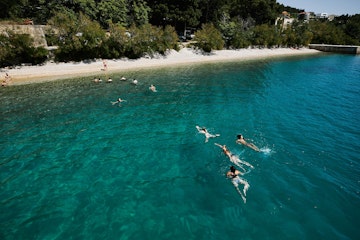
Oslič Beach
Only a few steps from Stari Grad Old Town, Oslič Beach patiently waits. A small stretch of coast made up of sand, rocks, and a concrete plateau become a beautiful escape to rest and recharge. Oslič Beach truly shines come sunset when the sun dips between the gap of two distant coastlines, reflecting the sky’s warm hues onto the Adriatic waters below. This also makes for a pleasant evening stroll with only the sounds of the sea in the background.
Stari Grad is a testament to perseverance and preservation, successfully honoring the land over the centuries. With a history as long as its own, you won’t be short of opportunities to revel in the glory and heritage this ancient town has maintained.


